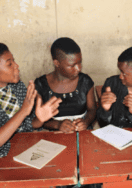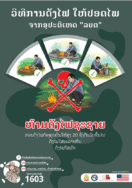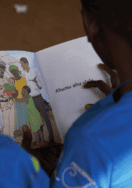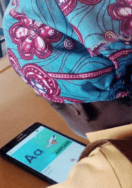Multilingual Education Breaks Down Barriers
February 20th, 2024 | Blogs
Language is not just a means of communication; it’s a gateway to knowledge, understanding, and opportunities. Instructing students in their mother language helps them grasp concepts more easily and allows parents and communities to engage with their children’s learning. It also promotes inclusivity and ensures all individuals can receive crucial health and safety information. Once students have a strong foundation for learning in their mother tongue, instruction in the national language can be added as students progress through school to ensure access to higher education and employment opportunities.
World Education has worked for decades to establish and strengthen structures for learning in local languages around the world.
 In Malawi, the DARE DREAMS initiative through the Ana Patsogolo Activity is expanding inclusive education for adolescent girls and young women who are deaf or hard of hearing. We are adapting the DREAMS model to accommodate their needs, creating a dedicated learning space and providing comprehensive support that includes transportation to learning groups and sign language interpretation. These learning sessions develop the girls’ sign language skills and provide skill-building opportunities, with lessons on sexual and reproductive health, financial literacy, and HIV and gender-based violence prevention. By training other young women who are deaf to facilitate learning sessions, DARE DREAMS is working to ensure everyone has the opportunity to learn in their own language.
In Malawi, the DARE DREAMS initiative through the Ana Patsogolo Activity is expanding inclusive education for adolescent girls and young women who are deaf or hard of hearing. We are adapting the DREAMS model to accommodate their needs, creating a dedicated learning space and providing comprehensive support that includes transportation to learning groups and sign language interpretation. These learning sessions develop the girls’ sign language skills and provide skill-building opportunities, with lessons on sexual and reproductive health, financial literacy, and HIV and gender-based violence prevention. By training other young women who are deaf to facilitate learning sessions, DARE DREAMS is working to ensure everyone has the opportunity to learn in their own language.
 In Laos, the Lawang (“Beware”) project is delivering vital explosive ordnance risk education messaging to communities in danger of accidents from unexploded ordnance (UXO). Building on years of World Education’s work to raise awareness and prevent harm, this project reaches a wider audience through a coordinated media campaign. Key to this approach is delivering messages in three local languages in addition to the national language of Laos. Through a combination of social media, radio, community loudspeakers, and more, our goal is for everyone in Laos – regardless of age, location, or language – to understand the risks of UXO and take proper precautions.
In Laos, the Lawang (“Beware”) project is delivering vital explosive ordnance risk education messaging to communities in danger of accidents from unexploded ordnance (UXO). Building on years of World Education’s work to raise awareness and prevent harm, this project reaches a wider audience through a coordinated media campaign. Key to this approach is delivering messages in three local languages in addition to the national language of Laos. Through a combination of social media, radio, community loudspeakers, and more, our goal is for everyone in Laos – regardless of age, location, or language – to understand the risks of UXO and take proper precautions.
 In Mozambique, the SABER program is expanding bilingual education across the country, providing an increasing number of students with the opportunity to learn in their local languages. Studies have shown that bilingual education makes it easier for students to build foundational literacy and numeracy skills, improving learning outcomes and increasing engagement in education. Through investments in teacher training and materials development, SABER is strengthening the capacity of the education system to provide instruction in local languages and a smooth transition to learning in the national language, which is key for students’ future success.
In Mozambique, the SABER program is expanding bilingual education across the country, providing an increasing number of students with the opportunity to learn in their local languages. Studies have shown that bilingual education makes it easier for students to build foundational literacy and numeracy skills, improving learning outcomes and increasing engagement in education. Through investments in teacher training and materials development, SABER is strengthening the capacity of the education system to provide instruction in local languages and a smooth transition to learning in the national language, which is key for students’ future success.
 In Ghana, the Read Along pilot eased the transition from local to national language instruction to enhance the academic and professional development of girls. Many adolescent girls in Ghana struggle with building the English skills needed to excel in school, so we partnered with Google to facilitate learning in an efficient and engaging way. The girls used the Read Along app to practice each day for three months, playing games and reading stories that can be accessed offline, supported by a virtual helper and a trained mentor teacher. After three months, the girls showed significantly improved proficiency in the national language.
In Ghana, the Read Along pilot eased the transition from local to national language instruction to enhance the academic and professional development of girls. Many adolescent girls in Ghana struggle with building the English skills needed to excel in school, so we partnered with Google to facilitate learning in an efficient and engaging way. The girls used the Read Along app to practice each day for three months, playing games and reading stories that can be accessed offline, supported by a virtual helper and a trained mentor teacher. After three months, the girls showed significantly improved proficiency in the national language.
By implementing targeted initiatives that cater to diverse linguistic needs, we can ensure that all learners have equal access to education and opportunities for success. Multilingual education helps ensure language is not a barrier, but a doorway.
World Education fosters enduring partnerships across regions and sectors to advance education outcomes for all. We offer education systems strengthening, program design and implementation, applied research and evaluation, capacity development, and policy development services.